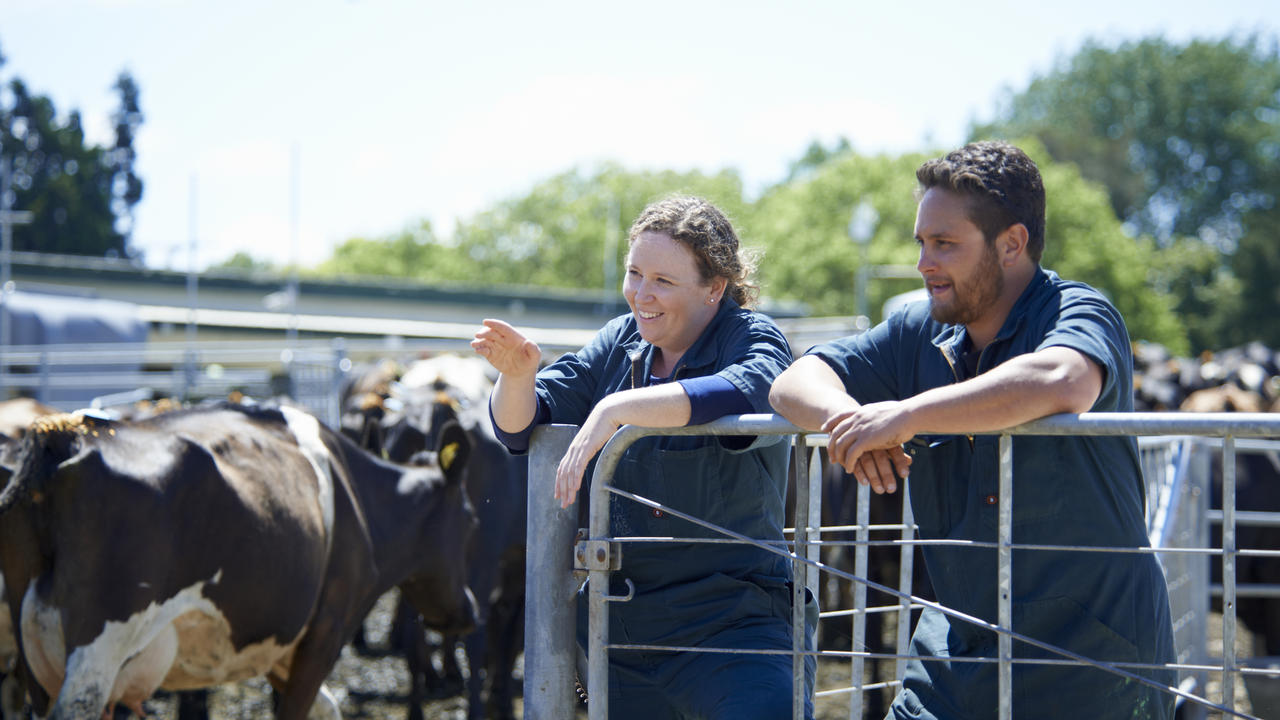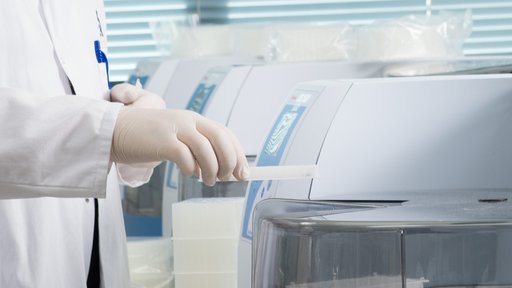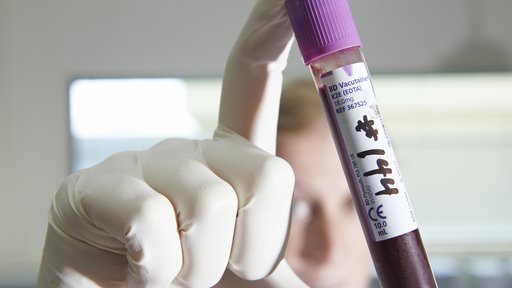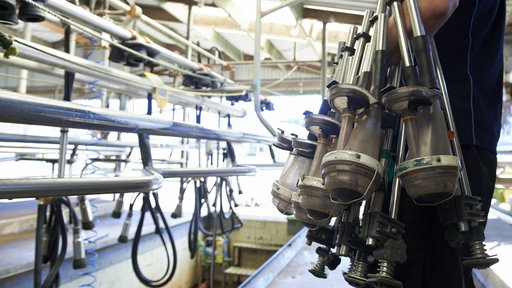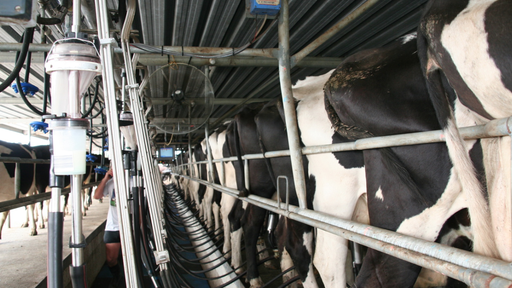Subscribe to Vetline
Keep up to date with LIC's products and services.
And receive the quarterly Vetline newsletter.
To book an Animal Health test online, please click the link below:
Animal Health Booking Vet Form
Subscribe to Vetline
Subscribe to our Vetline newsletter to keep up to date with the latest news about LIC products and services.
BVD - Webinar
View the recording of the BVD - Vet webinar
Topics covered
- BVD Bulk tank milk result interpretation
- New BVD Status product
- Changing to Wet TSU's, what this means for vets
- Trial for BVD testing on Wet TSU's for calves under 35 days old
BVD testing for calves – Webinar
View the recording of the BVD testing for calves Webinar
Topics covered
- BVD PCR test using tissue samples
- Trial data for BVD Ag ELISA & PCR testing for calves
- Difference between wet & dry tissue sampling units(TSU’s)
- Q & A
Johne’s disease – Webinar
View the recording of the Johne’s disease webinar
Topics covered
- Johne’s disease timeline
- Johne’s diagnostics testing with LIC
- New data reporting for Johne’s disease
- Johne’s disease research at LIC
- Johne’s disease farmer success stories
MINDA Reproduction provides comprehensive information about a herd’s reproductive performance. By using MINDA Reproduction you are able to monitor the herd throughout their reproductive cycle from pre-mating through to mating and calving to identify any potential issues in a timely manner.
Download the guide to the Reproduction tile in MINDA for detailed explanations on the data available and some rules of thumb to help with your data analysis.
We are now offering a new and improved test to help you better detect mastitis in your herd.
The Mastitis Multiplex PCR test provides more information and greater accuracy at a lower cost and will replace LIC’s existing Staph. aureus PCR test.
Click here to learn more.
Johne’s disease is a chronic infection caused by a bacterium called Mycobacterium avium subspecies paratuberculosis (MAP). This bacterium infects the gut of cattle and other ruminant animals, causing the intestinal wall to gradually thicken and become inflamed. This results in leakage from the gut wall and prevents the animal from absorbing vital nutrients.
Johne’s disease is widespread amongst NZ dairy herds. It costs the industry between $40 million and $90 million every year in lost milk production and poor calving rates.
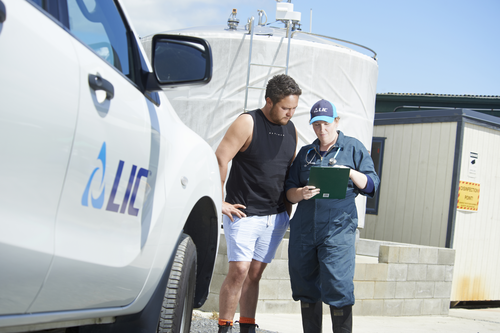
What are the symptoms?
Johne’s disease may lead to:
- ill thrift
- lower milk production
- difficulty reproducing
- weight loss
- diarrhoea
- swelling under the jaw, also known as ‘bottle jaw’.
How is it spread?
Johne’s disease is primarily spread through:
- faeces
- contaminated pasture
- colostrum/milk
- contaminated feed
- contaminated water source.
Infected cows start shedding bacteria some time before clinical signs of disease appear. As the infection progresses, increasing amounts of bacteria are excreted in the faeces of heavy shedder cows.
Calves may pick up the infection in the calving paddock and remain at risk if they are exposed to faeces or effluent from the adult herd. Cows with advanced infection (both clinical and subclinical) can also transmit the bacteria to the unborn calf in utero and via colostrum or milk.
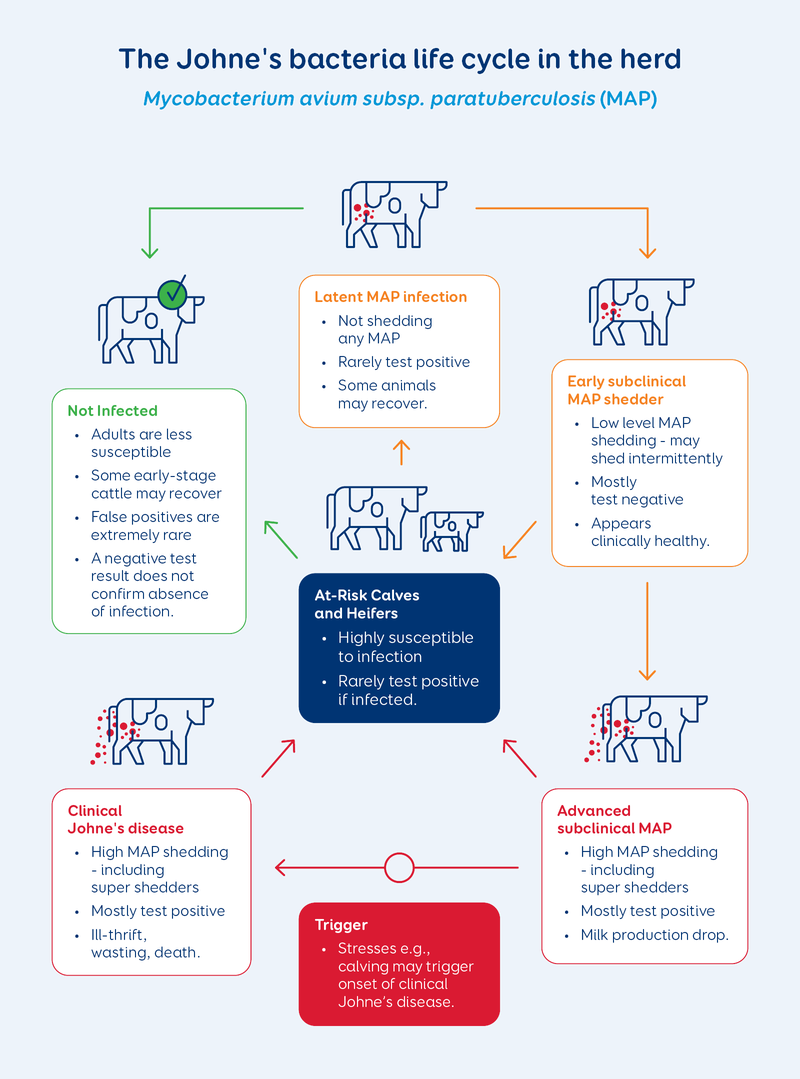
How can Johne’s disease be managed / controlled?
During the early stages of Johne’s disease, infection diagnostic tests are unreliable, so controlling it can be a challenge.
It is possible to minimise the impact of Johne’s disease by reducing the exposure of young stock to the disease. The severity of Johne’s disease in an individual (i.e., time until clinical signs develop and the amount of faecal shedding) depends on several factors including the age when infection occurred, the amount of bacteria ingested and the number of times the animal has been exposed to Johne’s disease bacteria. Therefore, any management measures that reduce exposure (e.g., avoiding effluent paddocks and paddocks grazed by the adult herd) will help limit disease spread.
Risks and control measures can vary from farm to farm. Keys to a successful risk management plan are:
- eliminating the source of bacteria by testing and early removal of clinical Johne’s disease cows and other sub-clinical MAP shedders
- removing susceptible calves and young stock from possible sources of infection as soon as practicable. Do not feed calves colostrum from infected cows. Pick up calves from paddock as often as possible
- good farm biosecurity – ask for a Johne’s testing history when purchasing calves, heifers or adult cows.
Convenient testing
LIC offer Johne’s testing for dairy cows on herd test milk samples & blood samples to identify cows with sub-clinical or clinical Johne’s disease.
Test limitations and timing
The Antibody ELISA test detects the immune response of the animal to MAP infection. While it generally does not identify cows during early stages of subclinical infection (i.e., low-risk non-shedders or intermittent/low shedding), the test performs very well in advanced stages of Johne’s disease.
The test will identify 8-9 out of 10 cows with clinical disease, or those that are excreting large amounts of bacteria (heavy and super shedders).
You can test at any time of the year, but we recommend focusing on the second or third herd test (November-March). Although you can test at the first or fourth herd test, please note false positives may occur if:
- cows have recently calved (within 7 days of herd test)
- SCC is >1 million
- low milk volumes - avoid testing too close to dry off or when part of the herd has dried off.
Risks
Testing for Bovine Tuberculosis (TB) before the herd test may increase the number of uninfected animals being given a suspect result in Johne’s disease ELISA testing. The risk for false positive or false high positive results may also be increased. TB tests can affect blood serum Johne’s disease ELISA, therefore any confirmation testing completed after the herd test may be impacted.
Our advice aligns with UK recommendations to leave the following gaps between your TB test date and JD ELISA test:
- 43 days before milk JD ELISA
- 71 days before blood JD ELISA.
Where possible, TB testing should be done after JD ELISA to avoid any possible issues.
For more information download the TB test interference with JD ELISA-Literature Review.
Further information
For further information, please contact LIC's Animal Health Team on 0800 436 362 or email [email protected]

Use our A2 gene test to identify cows that produce A2 milk.
About 30% of New Zealand dairy cows produce A2 milk. It contains a protein called A2 β- casein. A1 milk contains A1 β- casein, or a mix of both A1 and A2 β- casein.
Some consumers are willing to pay more for A2 milk because they believe it prevents the digestive problems they say they experience after drinking A1 milk. We do not endorse any of the claims made about A2 milk. If you want to set up an A2 herd, every animal in the herd must have the A2 gene. You must also breed with bulls that have the A2 gene.
How You Can Get A2 Test Results
Choose the option that suits you:
- Do you have already DNA profiled animals?
✔ Get A2 result in 5–7 working days - Take a tissue sample and combine A2 to DNA testing?
✔ Results in 4–5 weeks - Add A2 test to herd test?
✔ Results in 10 working days - Standalone A2 test (tissue sample)?
✔ Results in 3 weeks
For information about taking samples and submitting samples, view our A2/A2 test page.
Download a PDF about A2/A2 testing.
BVD Brochure-Learn how to protect your herd from BVD
Download the BVD Animal Health Brochure and learn how to protect your herd.
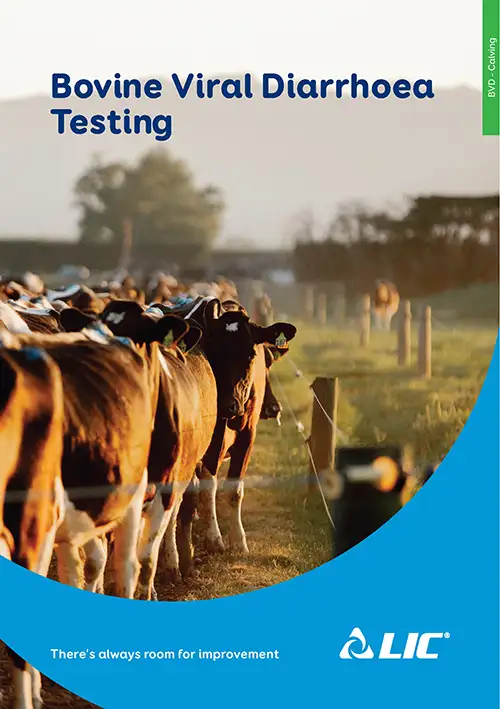
Protect Your Herd from BVD
LIC offers multiple testing options to help New Zealand dairy farmers monitor and detect BVD (Bovine Viral Diarrhoea) in their herds — using milk, blood, and tissue samples.
Milk Testing Options
- BVD Status Pack (Best all-in-one option)
Combines herd-level and individual cow testing across the season:
- Test 1: Early-season bulk milk, testing for the BVD virus & antibody exposure levels
- Test 2: Herd test milk samples for individual cow BVD status (results uploaded to MINDA as PI or NPI)
- Test 3: Bulk milk follow-up to check PI animals are removed, testing for BVD virus
- Test 4: Late-season bulk milk to assess antibody exposure levels
Turnaround for results:
- Bulk tank milk samples -5 working days
- Individual herd test samples – 7 working days from when you receive the herd test lab strip result.
- Annual testing: Once signed up the pack rolls over each year
Bulk Milk BVD Monitoring Pack
Three bulk milk tests during the season to monitor your herds BVD status (before mating, 2 weeks later and then post mating)
- First two samples are tested for BVD Virus (PCR) & Antibody ELISA(Ab)
- Last sample is tested for Antibody ELISA(Ab) only
- Helps track BVD infection status and herd immunity
- Ideal for regular annual monitoring
- Turnaround for results: 3-5 working days
- Annual testing: Once signed up the pack rolls over each year
BVD PI Hunt
- Tests individual animal milk samples to identify persistently infected (PI) animals for culling
- Used if BVD virus is detected in earlier BVD bulk milk tests
- There are options to test every cow or a selected list such a heifers or bottom 20% of herd.
- Turnaround for results: 5-7 working days.
Blood & Tissue Testing Options
Used to:
- Detect PI animals
- Screen new herd additions, calves, yearlings and natural mating bulls
Three test options:
- Calf BVD PCR: Calves under 35 days
- BVD PCR: Animals over 35 days
- BVD Antigen ELISA: Animals over 35 days
More information about BVD testing calves.
Tissue Testing:
- Add BVD testing to DNA samples
- Use the correct TSU (wet or dry) based on age of animal and test type. Click here for more information on how to collect and send tissue samples for standalone BVD testing, and how to combine the BVD test with DNA parentage testing.
- Turnaround for results: 3–6 days depending on test selected
More information about Wet TSU’s.
How to Order
- Call 0800 436 362
- Talk to your LIC rep
- Email completed order forms to [email protected], all animal health & DNA submissions forms listed at bottom of this page.
Resources
- Download the BVD Animal Health Brochure or Info Sheet
- Talk to your vet or LIC Animal Health Advisor for guidance
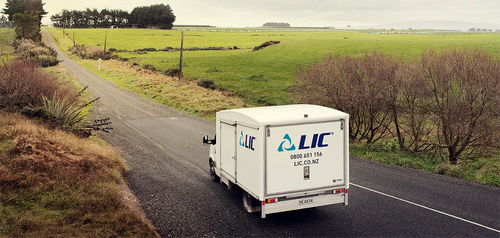
Milk Pregnancy Testing (MPT) is a simple, convenient & non-invasive option for non aged pregnancy diagnosis.
How it Works
- Utilises herd test milk samples to detect pregnancy associated glycoproteins produced by the placenta.
Key Benefits
- Detects pregnancy from 28 days after mating
- Easy and convenient – no need for extra farm visits
- Non-invasive – no handling or stress for cows
- You can test the whole herd or a selected group (minimum of 25 cows).
Results
- Results are sent to MINDA and emailed to you
- You’ll receive results 5–7 working days from when the herd test lab strip is received
- The emailed report will show one of three outcomes:
- Pregnant
- Re-check (needs pregnancy diagnosis confirmed by other means)
- No Pregnancy Detected.
In MINDA, results will be shown as:
- Pregnant MPT
- Re-check
- Empty (If an animal has been tested within 28 days of their last mating, an empty result may be given).
Test Limitations
- The milk pregnancy test does not age pregnancy
- The milk pregnancy test accurately detects pregnancy 28 days after mating
- Majority of herds will have <5% of cows in the recheck category; however up to 10% rechecks could be expected.
Risks
- If a cow recently lost a pregnancy, it can take at least two weeks for pregnancy protein levels to drop following a slip. If the herd test date falls within this period this animal may still give a ‘Pregnant’ result.
Further Information
For further information, please contact the Animal Health Advisor’s team at LIC on 0800 436 362 or email [email protected]
Download a PDF about Milk Pregnancy testing.
Complete the Animal Health Sample Submission Form if you are sending blood or tissue samples to test for:
- Johne’s disease in individual animals
- BVD in individual animals.
- Enzootic Bovine Leukosis (EBL)-Please note samples will be pooled but resulted individually
Animal Health Sample Submission form
Johne’s disease blood test
Tick Johne’s disease ELISA on the Animal Health Sample submission form to test for Johne’s disease in blood samples from individual animals.
BVD blood tests
Choose from one of four BVD blood tests:
- BVD PCR — detect the virus in animals over 35 days old.
- Calf PCR — detect the virus in calves less than 35 days old.
- BVD antigen ELISA — detect the virus in animals over 35 days with a slightly faster turnaround time for results.
- BVD antibody ELISA — test whether an animal has been exposed to the BVD virus.
BVD tissue test
Tick BVD antigen ELISA on the submission form to test for the BVD virus in tissue samples from animals over 35 days old.
Tick Calf BVD PCR on the submission form to test for the BVD virus in tissue samples for animals under 35 days old.
Animal Health Sample Submission form
Courier the samples, with the completed forms, to:
LIC Diagnostics
140 Riverlea Road
Riverlea
Hamilton 3216
Use the appropriate submission form below for any milk sample testing– email completed forms to [email protected]
A2A2 Herd Testing Submission form
Animal Health Sample Submission form
Bulk Milk BVD Monitoring Pack order form — Farmer
Bulk Milk BVD Monitoring Pack order form — Vet
BVD Status Pack Submission Form - Farmer
Subscribe to Vetline
Keep up to date with LIC's products and services.
And receive the quarterly Vetline newsletter.
